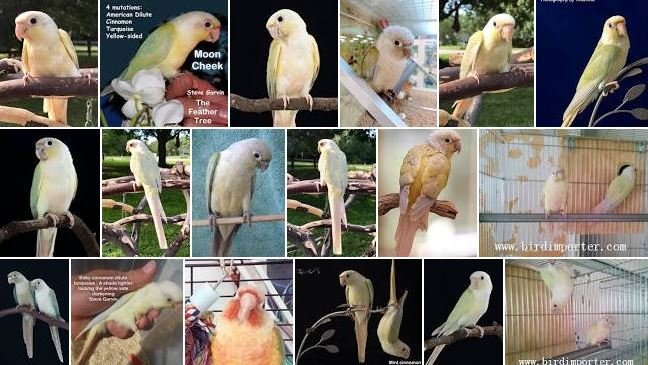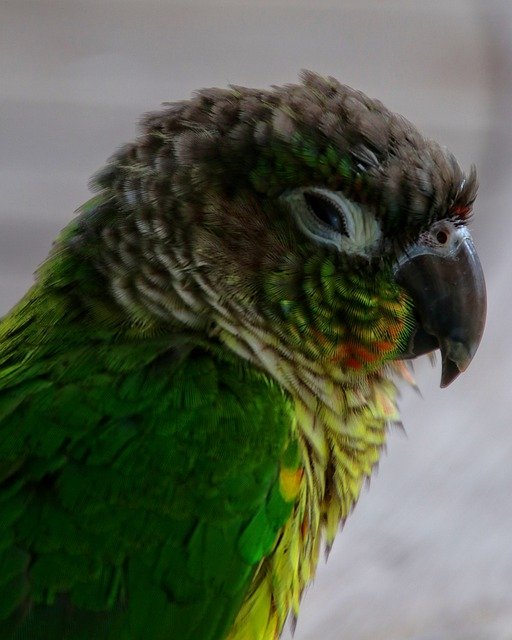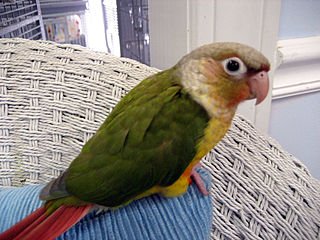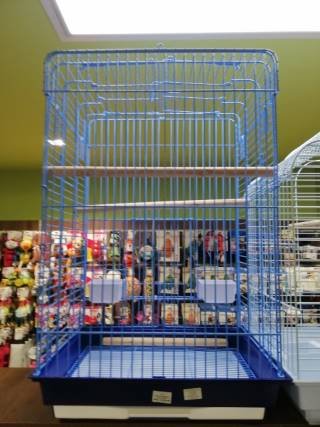Found in the woods and wilderness of Paraguay, Argentina, and Brazil, the Moon Cheek Conure is one of the unique mutations of the Green Cheek Conure. Green Cheek Conure appears in a variety of colors and phenotypes. Rare, Turquoise- American Dilute- Yellow-Sided- Cinnamon combination in the look, it is a mutation of Sun Cheek and Turquoise. With such a unique combination, that the Moon Cheek Conure is an out-and-outer among the birds.
Its light blue color, with the white chest, makes it extremely pretty. They have a white beak and white feet. Resembling the moonlight in its light colors the name suits them well. The unprecedented appearance combined with the personality, the convenience of caretaking, makes their owners adore them.
CHARACTERISTICS
Moon Cheek Conure Size
Moon Cheek Conures are relatively small in size. Up to 10 inches long, this species is famous for its compactness. They are a good pet choice, especially for children, or for the apartment. They can fit in the hand, and with their affectionate nature, make great friends. Overall, they are space-efficient, as they could take up only a corner of the house.
Moon Cheek Conure Behavior
Not only due to the size but for their tender nature, they are praised by parents. Moon Cheek Conure is attractive, fun, and a real attention seeker. Often described as comical, their interactive behavior contributes to the strong bonds they create with people.
Just as children, these birds can be nasty at times. This way, they can teach their young owners a valuable lesson of the responsibility that having a pet brings. This being said, keeping this type of Conure takes some skill, experience, or the love for animals stimulating patience in their training. When denied attention, they can get nippy, but it’s not characteristic for Moon Cheek Conure. In contact with children, protecting the hands should be considered, so the birds don’t hurt them when irritated. Moon Cheek Conures are considered shy. However, they need a great social interaction with the owner. Comforting their needs will prevent them from developing any behavioral problems, so they can be easily kept in any household.
Moon Cheek Conure Intelligence
Moon Cheek Conure is an intelligent bird. The first sign is a social and bonding ability. This means they can recognize the owner, distinguishing the stimuli. They respond to training, learning the behavior patterns, such as meal schedule. As lively as they are, performing various tricks, movements, and acrobatic is easy for them.
Moon Cheek Conure Talking ability
They can adopt manners, but also the talking ability, even though they don’t pride themselves on this. The vocals range they possess is not so wide, so communication with them is convenient. Moon Cheek Conure’s speech isn’t clear, but they do pick up some words.
They are relatively quiet, compared to the other relatives. The softer voice makes them ideal form the apartment keeping. Typically, when they are several months old, they start reproducing a couple of words. If well taken care of they are calm, although they can produce some noise.
Moon Cheek Conure Life Span
It is not easy to predict the lifespan of the Moon Cheek Conures. As on average, they live up to 15 years. It’s thought to be due to the lack of dedication from the owner since it can live up to 25 years if it is well taken care of.
Moon Cheek Conure Gender difference
Physically, the gender difference of the Moon Cheek Conures is invisible. Male and female birds also behave similarly. Although the mail can be a bit more careful and aggressive when it comes to the territory, and females slightly more affectionate, this is not a rule. It depends on the bird. Also, they can be trained, so the difference in the behavior is not a reliable gender determining factor. Taking the DNA test or the pelvic examination is recommended instead. Tests may be conducted in the home environment. The analysis would point out the sex hormones. The pelvic test would show the width of the hips of the female Conure.
CARE
Moon Cheek Conures are brilliant pets since they create bonds with the owner. Affectionate and cuddly, the species is irresistible. The value of personal freedom makes them slightly demanding. They love to spend time out of the cage and need an owner that can support them there. When happy and satisfied, they produce specific sounds. Singing, whistling, chattering, and authentic purring. Purring can also demonstrate the discomfort. Moon Cheek Conures love baths, and those are recommended a couple of times a week. They molt once a year, typically after they turn 8 months. Usually, molting takes place in autumn since the feathers get damaged.
Moon Cheek Conure Cage
Regardless of the flexibility degree that you offer to your Moon Cheek, choose the cage wisely. It should be vast and light since they prefer brighter spaces. Avoid placing them in dark boxes, as it would stimulate their mating instinct, causing the stress. In order to avoid nipping, make use of the toys.
To accommodate their activity levels, it’s recommended to give them a spacious home, in vertical and horizontal lines. The ideal dimensions would be 18 x 18 x 24 inches. In between the bars, no more than 1 inch of space is allowed for the best safety of the bird.
As Conures value their peace and sleep time as well, cage location is important. Placing it above the ground, somewhere quiet, without interruption, on a table, for instance, would give them maximum comfort.
If you keep more of Conures, it’s recommended to pair them with the ones of similar size. They tend to be aggressive when around smaller birds. Alongside this, interacting with bigger birds may be dangerous. Bonding shouldn’t be forced, however. It should be a rather gradual transition. Watch out the process and interaction. In the end, space is important for them, so if the cage is not big enough, keep them separately.
Moon Cheek Conure Breeding
Breeding season begins in mid-spring. Regardless of the potential, don’t take them into breeding unless a year old. If it begins at the right point during the season, there can be up to three clutches of babies per season. This period is sensitive to them. For the successful breeding, a comfortable environment, including the mild temperature range should be arranged.
The Moon Cheek Conure Breeding Cage
The cage should be big enough to host female and male Conure. In this period, hormones are going wild, so the personal space and freedom are on demand. Otherwise, they tend to be nervous. Dietary requirements escalate too.
The Moon Cheek Conure Breeding Box
The breeding box needs to be deep enough, preferable 16 to 24 inches. As of the base, 6 x 8 inches would work. Leave an entrance hole of 3 inches. If you like to keep it low-cost, or just like crafting these breeding boxes may be produced at home. Customized, using plywood and some handy tools, it’s a useful, and engaging activity.
Moon Cheek Conure Diet
Moon Cheek Conure’s diet should be nutritious and balanced. They should be given fresh vegetables, fruits, and healthy supplements. Owners should keep an eye on their chewing needs when choosing the supplements since they have hasty beaks. Nuts and seeds should be incorporated, preferably as treats. Food low in fat is recommended. It should be as varied as in their natural habitat
The Moon Cheek Conure Price
For their unique genotype, this piece of the Conure is relatively pricy, Ranging from 500 to 800 dollars per single parrot. The price depends on the period of life too. The older they are, the more expensive they get. Weaning phase is the most expensive.
Buying them in pairs gets you a discount on the single bird, although the total price is higher. In general, have in mind that having a pet brings the regular rounds of expenses, such as food supplements, veterinarian care, toys, etc.
Summary
Elegant and affectionate species of the Conure, the Moon Check Conure is a rare mutation with treats of Dilute, Turquoise, and Cinnamon Green Cheeked Conure traits combination. Although unique in look, it is much more than a sophisticated palate color choice.
The Mooncheeks are small in size, quieter than the other Conures, but also lively. They appreciate the openness and lightness of their space. Pronouncing certain words can be thought, but the speech is not their strongest point. Seeking love and care, they create a strong bond with owners.
Intelligent, MoonCheeks are a great option for the apartment environment, since they don’t consume much of the space, and their soft voice isn’t an issue for the neighbors.
With all that being said, this interesting and exotic animal is most likely to be kept by an experienced pet owner and an enthusiastic animal lover. They can be hands full of a job but you will get all of your affection compensated with love and joyfulness these creatures can bring.



